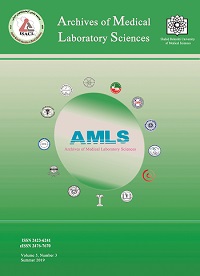Applying Immunoinformatics Methods to Identify Potential T and B Cell Epitopes in the CagA Protein of Helicobacter pylori
Archives of Medical Laboratory Sciences,
Vol. 5 No. 3 (2019),
1 July 2019
,
Page 1-6
https://doi.org/10.22037/amls.v5i3.30561
Abstract
Background and Aim: Helicobacter pylori is not only identified as a leading cause of chronic active gastritis and peptic ulcer disease in humans, but also it is considered as a risk factor for the development of gastric adenocarcinoma and MALT lymphoma. This study aims to predict specific epitopes for the utility of designing peptide vaccine against H. pylori infection by targeting invasive, virulent and membrane associated proteins CagA. Materials and Methods: In the present study, various immunoinformatics approaches have been applied to design a potential epitope-based vaccine against H. pylori infection. For prediction of linear epitopes, the sequence of CagA was submitted to ABCpred, BCPREDS, Bcepred, Bepipred and Ellipro servers. DiscoTope 2.0 and B-pred servers were also used for the prediction of conformational epitopes. In addition, prediction of T-cell epitopes was carried out by CTLPred. Results: The obtained results demonstrated 277 conformational B-Cell epitopes in addition to predicted high score linear B and T cell epitopes in CagA protein. Conclusion: These predicted epitopes might be used to design a vaccine against H. pylori and thus, could be validated in model hosts to verify their efficacy as vaccine.
- CagA
- Helicobacter pylori
- B cell Epitope
- T cell Epitope
- In silico
How to Cite
References
Kuipers E, Pena A, Festen H, Meuwissen S, Uyterlinde A, Roosendaal R, et al. Long-term sequelae of Helicobacter pylori gastritis. The Lancet. 1995;345(8964):1525-8.
Parsonnet J, Friedman GD, Vandersteen DP, Chang Y, Vogelman JH, Orentreich N, et al. Helicobacter pylori infection and the risk of gastric carcinoma. New England Journal of Medicine. 1991;325(16):1127-31.
Suerbaum S, Michetti P. Helicobacter pylori infection. New England Journal of Medicine. 2002;347(15):1175-86.
Censini S, Lange C, Xiang Z, Crabtree JE, Ghiara P, Borodovsky M, et al. cag, a pathogenicity island of Helicobacter pylori, encodes type I-specific and disease-associated virulence factors. Proceedings of the National Academy of Sciences. 1996;93(25):14648-53.
Del Giudice G, Covacci A, Telford JL, Montecucco C, Rappuoli R. The design of vaccines against Helicobacter pylori and their development. Annual review of immunology. 2001;19(1):523-63.
Suttona P, Boag JM. Status of vaccine research and development for Helicobacter pylori. Vaccine. 2019;37:7295–9.
Zhang S, Moise L, Moss SF. H. pylori vaccines: why we still don't have any. Human vaccines. 2011;7(11):1153-7.
Hayman WA, Brandt ER, Relf WA, Cooper J, Saul A, Good MF. Mapping the minimal murine T cell and B cell epitopes within a peptide vaccine candidate from the conserved region of the M protein of group A streptococcus. International immunology. 1997;9(11):1723-33.
Rothbard JB, Taylor WR. A sequence pattern common to T cell epitopes. The EMBO journal. 1988;7(1):93-100.
Yasser E-M, Honavar V. Recent advances in B-cell epitope prediction methods. Immunome research. 2010;6(2):S2.
Blythe MJ, Flower DR. Benchmarking B cell epitope prediction: underperformance of existing methods. Protein Science. 2005;14(1):246-8.
Nielsen M, Lund O, Buus S, Lundegaard C. MHC class II epitope predictive algorithms. Immunology. 2010;130(3):319-28.
Saha S, Raghava G, editors. BcePred: prediction of continuous B-cell epitopes in antigenic sequences using physico-chemical properties. International Conference on Artificial Immune Systems; 2004: Springer.
Saha S, Raghava G. Prediction of continuous B‐cell epitopes in an antigen using recurrent neural network. Proteins: Structure, Function, and Bioinformatics. 2006;65(1):40-8.
Haste Andersen P, Nielsen M, Lund O. Prediction of residues in discontinuous B‐cell epitopes using protein 3D structures. Protein Science. 2006;15(11):2558-67.
Urrutia-Baca VH, Gomez-flores R, De La Garza-Ramos MA, Tamez-guerra P, Lucio-sauceda DG, Rodríguez-padilla MC. Immunoinformatics Approach to Design a Novel Epitope-Based Oral Vaccine Against Helicobacter pylori. J Comput Biol. 2019;26:1177–90.
Bhasin M, Raghava GP. Prediction of CTL epitopes using QM, SVM and ANN techniques. Vaccine. 2004;22(23-24):3195-204.
Singh H, Raghava G. ProPred: prediction of HLA-DR binding sites. Bioinformatics. 2001;17(12):1236-7.
Reche PA, Glutting J-P, Zhang H, Reinherz EL. Enhancement to the RANKPEP resource for the prediction of peptide binding to MHC molecules using profiles. Immunogenetics. 2004;56(6):405-19.
Franke R, van Gerven J. Theoretical drug design methods. 1984.
Akopyants NS, Clifton SW, Kersulyte D, Crabtree JE, Youree BE, Reece CA, et al. Analyses of the cag pathogenicity island of Helicobacter pylori. Molecular microbiology. 1998;28(1):37-53.
Bergmann-Leitner ES, Chaudhury S, Steers NJ, Sabato M, Delvecchio V, Wallqvist AS, et al. Computational and experimental validation of B and T-cell epitopes of the in vivo immune response to a novel malarial antigen. PloS one. 2013;8(8):e71610.
- Abstract Viewed: 135 times
- pdf Downloaded: 70 times
